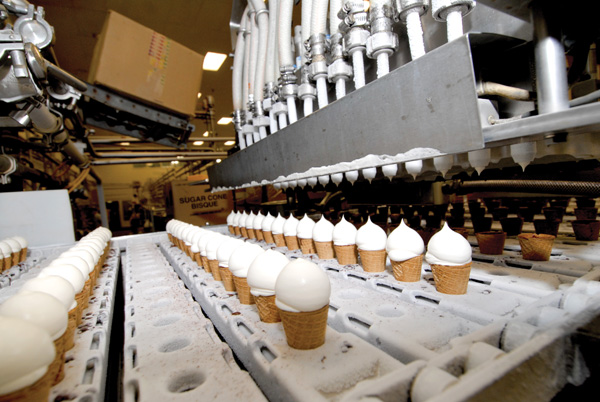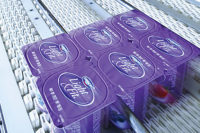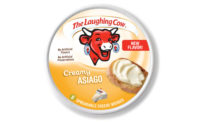

Of course, the building – on the aptly named Creamery Street in Brenham, Texas – has been expanded and updated over the years. But this small facility is still responsible for making 45,000 dozen frozen stick novelties every day, including Homemade Vanilla, Chocolate Fudge and Chocolate Chip Cookie Dough bars.
“We don’t have a lot of new technology here – it’s basic equipment that does a good job,” says Greg Bridges, production manager. “We have a lot of good long-time employees who know how to keep them going.”
This facility – a former cotton mill acquired by the original Brenham Creamery Co. in 1907 to process milk and butter – was supposed to have been shut down in 1972, when the current flagship plant and corporate offices opened a few miles away. But growing demand for Blue Bell products made it necessary to keep it up and running, says Bill Weiss, public relations manager. “This plant started out small, by today’s standards, and has been added onto many, many times,” he says.

Snack size
Jason Jenkins, manager of what Blue Bell calls its snack plant, says 25 varieties of frozen novelties are made here, all stick products. Its six Vitaline machines churn out treats like chocolate-coated bars and ice pops in take-home and bulk packaging.Key to Blue Bell’s snack plant production is the “bottom-up” filler. Its nozzles are lowered into the molds to fill them from the bottom up, compared to a standard novelty machine on which the molds are filled from the top.
Bridges explains the advantages of the bottom-up filler: “You can put inclusions in the bars and not have them separate out. The consistency is better and you get a better texture on the ice cream.”
Chocolate-chip cookie dough bars were running on the bottom-up line on the morning of DFR’s visit; they’re dunked in a brown-sugar coating before they’re wrapped. Jenkins says the machine is also used for mint chocolate chip, chocolate-covered cherry, butter pecan and Homemade Vanilla bars. The Gram machine, installed about 1½ years ago, is an eight-wide filler that replaced a six-wide unit in use since 1968.
Bars take about eight minutes after their sticks are inserted to travel through the brine box before extraction. It takes about 20 minutes for a mold to make a complete revolution through the machine between fillings, Jenkins notes.

Box formers on an upper floor drop boxes down to the lines, where they’re manually packed, machine-sealed and cased by hand.
Three lines are located in the original building, while three more are in a more recent addition. “There’s a lot going on in a very small space,” Weiss remarks.
Over in the addition, an eight-wide Vitaline machine makes ice cream bars coated with chocolate and crispy rice. This particular line makes snacks for 12-pack boxes at 20 drops per minute, Jenkins explains. Meanwhile, another eight-wide Vitaline, with double molds inserted in each pocket to double its output, makes sugar-free fruit bars.
The plant tends to run the same or similar products on the same lines all the time to minimize maintenance and maximize efficiency. “For most of these machines, there’s not a lot of changeovers,” Jenkins says, noting that the bottom-up filler requires a bit more attention because it handles bars with inclusions. “Mostly we just change flavors or coatings.”
While the snack plant has some frozen storage – about 200 pallet spaces – products don’t usually stay here long. “Most of our day’s production goes over to the other plant for distribution,” Jenkins says. That’s about four truckloads a day, depending on output.
One would think the facility’s age and small size would present constant challenges to production, but Jenkins says the company has done a good job keeping the plant up to date. “Once you get used to it [the size], it’s not that big of a deal,” he says. “The plant was built long ago before we had a lot of the regulations we have now, but we’ve always been able to update as needed.”
The most significant changes came in 1999-2000, with a complete remodeling of electrical and ammonia systems, Jenkins notes. “Every year since then,” he adds, “we’ve upgraded something.”
New and bigger things may be in store for the snack plant. Paul Kruse, Blue Bell’s president and chief executive officer, revealed that the company recently purchased additional acreage behind the plant, but did not divulge any immediate plans for the property.

Package deal
Blue Bell also makes novelties at its headquarters plant on Blue Bell Road, site of the company’s corporate offices and tour center. Originally 50,000 square feet when it opened in 1972, the “package plant” was expanded in 1983, 1988, 1995 and 2006.Now boasting 580,000 square feet, this facility has nine novelty lines – six stick-bar lines, two cone lines and one sandwich line – that share space with 14 lines that handle packaged ice cream in cups, pints, quarts, bulk cans and Blue Bell’s signature full half gallons.
The cone lines can accommodate full-size cones at 10 across or mini cones at 14 across, Bridges explains.
During DFR’s visit, one of these lines was running mini cones dipped in chocolate and nuts. Rather than the cones getting dunked, a trough of chocolate coating and nuts rises up to enrobe the upside-down hanging cones from below. Bridges says this process tends to be neater and generate less waste.
This plant also features a bottom-up filler among its stick lines. One of the products made on this line is Blue Bell’s new Strawberry Fruit Bars, which contain about 45% fruit. An ingredient feeder adds strawberry chunks to the ice cream before the molds are filled. “This filler allows us to add a tremendous amount of berries,” Bridges says.
Nearby, a humble Lynch sandwich machine churns out ice cream sandwiches on a single line. “It’s an older machine, but it works well for our needs,” Bridges remarks.
Transitioning to the packaged side, the sundae cup line combines Blue Bell Homemade Vanilla with a chocolate swirl. Cups are lidded and mechanically tipped on their sides for manual bagging in 12-cup packs. Output for this new product is significant. “People really seem to enjoy these cups,” Bridges says.
Serving two dozen lines in the flagship plant are 40 flavor tanks tied into a battery of 35 freezers. “We do anything from pints to cups to halves to quarts,” Bridges says. “We like to put a lot of ‘goodies’ in our ice cream. Our consumers really like that. Some of the more extravagant flavors take more creativity to make, and we have a lot of creative people on the plant floor.”
On this day, one line is filling Banana Pudding, studded with vanilla wafers; another puts out tubs of Happy Tracks, a new flavor that features vanilla with a dark chocolate swirl and loaded with peanut butter cups. “With this flavor, you don’t get the full effect until you dig into it,” Bridges notes.
The process all begins when raw milk arrives from Texas-based member farms of Dairy Farmers of America, provoking one of Blue Bell’s many homespun slogans: “The milk we use is so fresh, it was grass only yesterday.”

As good or better
Blue Bell’s Brenham plants – one beyond the century mark and the other closing in on four decades – have become more automated through their histories, allowing the company to increase efficiencies without prohibiting flexibility.New technologies implemented over the years include the bottom-up fillers, a high-speed cup line, robotics and a Clear Orbit inventory system. Some of the more innovative technologies employed include Oracle Process Manufacturing-Materials Requirements Planning, which allows visibility into the plant material planning process.
Training programs and guidelines include the Supreme Suggestion program, which rewards employees for submitting suggestions that increase efficiency, quality or conservation; in-house inspections; department-specific safety trainers; first responders; and line-operation training.
In the area of food safety, Blue Bell plants undergo inspections twice a year, including a yearly supplier summary for new vendors and every two years for existing vendors. That’s in addition to routine processes for nutrition and allergen information, pest control, water supply testing and other plant checks.
“No ingredient is accepted if it doesn’t pass our requirements, and our requirements are higher than industry standards,” says Dave Hellmann, production coordinator. “We’ve had to reject loads of dairy ingredients in the past. It doesn’t take long for word to get out that Blue Bell won’t take just anything. Our ice cream won’t taste like Blue Bell if we use substandard ingredients.”
In short, Blue Bell does whatever it takes at the operations level to make ice cream and frozen snacks that it says are “better by a country smile.” Its efforts have paid off; Blue Bell is the eighth-largest-selling brand of frozen novelties in the country, according to data from Chicago-based SymphonyIRI.
The folks in Brenham get the job done, facing challenges along the way with yet another of their Lone Star State mantras: Work, don’t worry.

AT a glance
Blue Bell CreameriesSnack Plant
Location: Brenham, Texas
History: Built 1907; major renovations in 1999-2000, constant upgrades since then.
Size: 21,000 square feet
Employees: 60
Products made: Frozen stick novelties (ice cream and water ice)
Total processing capacity: 45,000 dozens daily
Freezers: 6
Filling: Six Vitalines (nine additional novelty lines at main plant)
Frozen storage: 200 pallet spaces
extras
The following companies are among the makers and providers of Blue Bell’s plant equipment and supplies:
Anderson
APV
Blommer Chocolate
Cherry Burrell
Cookie Kingdom
Danisco
David Michael & Co.
Ecolab
Eriez
Global Sticks
Gram Equipment
Huhtamaki
Kerry
Kraft
Lynch
Madera Nut Co.
OK
T.D. Sawvel
Stanpac
Tate & Lyle

